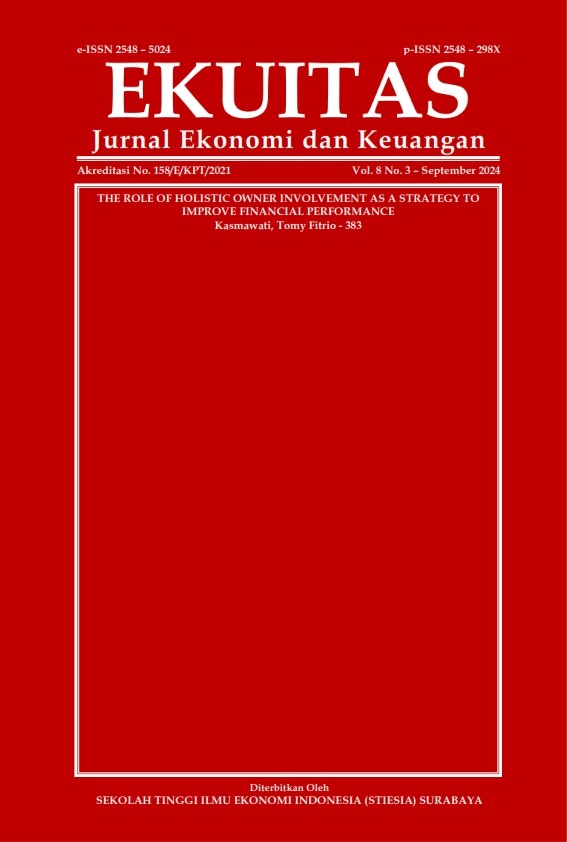SOCIAL MEDIA'S IMPACT ON CARDIGAN SHOPPING: TRUST, CONNECTION, AND QUALITY MATTER
DOI:
https://doi.org/10.24034/j25485024.y2024.v8.i3.6421Keywords:
social media interaction, source credibility, homophily sources, content quality, purchase intentAbstract
This study aims to analyze the effect of social media interaction on cardigan purchase behavior, with a specific focus on customer relationship management, purchasing intentions, and brand engagement. The study employs a quantitative methodology, gathering data from Instagram users aged 18 to 25 in the West Java Region who are acquainted with the Sweater Vest 'Cardigan' brand. The review employs a purposive sample of 220 respondents and uses the Likert scale survey. The investigation used the Partial Least Squares Structural Equation Modeling (PLS-SEM) method, which was specifically chosen due to the complex models and few samples. The findings reveal that virtual entertainment collaboration significantly influences sources of credibility, sources of homophily, and content quality, ultimately impacting purchase intention and behavioral engagement. This study enhances understanding the role of online entertainment in shaping consumer behavior. It also provides recommendations for companies to advance their networking capabilities, marketing credibility, and customer relationship management in cardigan shopping industry. Moreover, this study emphasizes the need for enterprises to prioritize the content quality and its impact on behavioral engagement to create value, and contribute valuable insights to the existing literature.
References
Adejare Yusuff, A., Arfan, S., & Shahizan, H. (2019). Factors affecting enterprise resource planning adoption on firms’ performance among medium-sized enterprises. International Journal of Supply Chain Management, 8(1), 142–149.
Agnès, H.-G., & Fanny, M. (2019). Consumer brand engagement and its social side on brand-hosted social media: how do they contribute to brand loyalty? Journal of Marketing Management, 35(7–8), 716–741. https://doi.org/10.1080/0267257X.2019.1599990
Alexa K., F., Chinintorn, N., & George D., D. (2019). Eat, drink, and create content: a multi-method exploration of visual social media marketing content. International Journal of Advertising, 38(3), 450–470. https://doi.org/10.1080/02650487.2018.1535223
Alexander P, S., Loes, J., & Maegan, V. (2020). Celebrity vs. Influencer endorsements in advertising: the role of identification, credibility, and Product-Endorser fit. International Journal of Advertising, 39(2), 258–281. https://doi.org/10.1080/02650487.2019.1634898
Alisha, C., & K, J. (2021). Influencer Marketing: An Analysis to Current World of Gen Z and Pre-Gen Alpha. Basic and Applied Research Journal, 3(1), 209–220.
Arta, I. G. S., & Yasa, N. N. K. (2019). the Role of Purchase Intention on Mediating the Relationship of E-Wom and E-Wom Credibility To Purchase Decision. Russian Journal of Agricultural and Socio-Economic Sciences, 86(2), 33–39. https://doi.org/10.18551/rjoas.2019-02.06
Artanti, R. A., & Rahmiyati, N. (2022). Pengaruh Likuiditas, Leverage Dan Struktur Modal Terhadap Nilai Perusahaan Dengan Profitabilitas Sebagai Variabel Mediasi. Prima Ekonomika, 13(2), 76. https://doi.org/10.37330/prima.v13i2.152
Atika, Kusumawati, A., & Iqbal, M. (2019). Ekuitas: Jurnal Ekonomi dan Keuangan The Effect of Electronic Word of Mouth, Message Source Credibility, Information Quality on Brand Image and Purchase Intention. Jurnal Ekonomi Dan Keuangan, 80, 94–108.
Chen, L., & Shupei, Y. (2019). Influencer Marketing: How Message Value and Credibility Affect Consumer Trust of Branded Content on Social Media. Journal of Interactive Advertising, 19(1), 58–73. https://doi.org/10.1080/15252019.2018.1533501
Chia, C.-C., & Ya, C. C. (2018). What drives purchase intention on Airbnb? Perspectives of consumer reviews, information quality, and media richness. Telematics and Informatics, 35(5), 1512–1523. https://doi.org/10.1016/j.tele.2018.03.019
Dabbous, A., & Barakat, K. A. (2020). Bridging the online offline gap: Assessing the impact of brands’ social network content quality on brand awareness and purchase intention. Journal of Retailing and Consumer Services, 53(March 2019), 101966. https://doi.org/10.1016/j.jretconser.2019.101966
Edin, S., Albert, B., & David J., L. (2021). Social media enabled interactions in healthcare: Towards a taxonomy. Social Science and Medicine, 291(September), 114469. https://doi.org/10.1016/j.socscimed.2021.114469
Emi, M. (2021). An empirical study on anthropomorphism and engagement with disembodied AIs and consumers’ re-use behavior. Psychology & Marketing, 38(1), 21–42. https://doi.org/https://doi.org/10.1002/mar.21407
Eric M., O., Kai M., O., Andrew J., C., & Thomas Martin, K. (2021). Business strategy and the management of digital marketing. Business Horizons, 64(2), 285–293. https://doi.org/10.1016/j.bushor.2020.12.004
Ertug, G., Brennecke, J., Kovács, B., & Zou, T. (2022). What Does Homophily Do? a Review of the Consequences of Homophily. Academy of Management Annals, 16(1), 38–69. https://doi.org/10.5465/annals.2020.0230
Eun Mee, K., & Jennifer, I. (2020). Online News Sharing in the Face of Mixed Audiences: Context Collapse, Homophily, and Types of Social Media. Journal of Broadcasting and Electronic Media, 64(5), 756–776. https://doi.org/10.1080/08838151.2020.1835429
Florin Sabin, F., Simona Mihaela, T., & Daniela Liliana, T. (2019). Customer relationship management capabilities and social media technology use: Consequences on firm performance. Journal of Business Research, 104, 563–575. https://doi.org/https://doi.org/10.1016/j.jbusres.2018.10.047
Ghozali, I. (2020). Konsep, Teknik dan Aplikasi Menggunakan Program SmartPLS 3.0 Untuk Penelitian Empiris. Semarang.
Giada, M., & Donata Tania, V. (2022). The influence of fashion blogger credibility, engagement and homophily on intentions to buy and e-WOM. Results of a binational study. Journal of Fashion Marketing and Management, 26(3), 473–494. https://doi.org/10.1108/JFMM-03-2020-0050
Hair et al. (2017). A primer on partial least squares structural equation modeling (PLS-SEM). In International Journal of Research & Method in Education (Vol. 38, Issue 2). https://doi.org/10.1080/1743727x.2015.1005806
Hendrayati, H., & Pamungkas, P. (2020). Viral Marketing and E-Word of Mouth Communication in Social Media Marketing. 117(Gcbme 2018), 41–48. https://doi.org/10.2991/aebmr.k.200131.010
Hollebeek, L. D., Srivastava, R. K., & Chen, T. (2019). S-D logic–informed customer engagement: integrative framework, revised fundamental propositions, and application to CRM. Journal of the Academy of Marketing Science, 47(1), 161–185. https://doi.org/10.1007/s11747-016-0494-5
Ivanov, O. A., Ivanova, V. V, & Saltan, A. A. (2018). Likert-scale questionnaires as an educational tool in teaching discrete mathematics. International Journal of Mathematical Education in Science and Technology, 49(7), 1110–1118. https://doi.org/10.1080/0020739X.2017.1423121
Jamie, C., Mohammad, R., Ranjit, V., & Natalie, D. V. (2018). Customer engagement behaviours in social media: capturing innovation opportunities. Journal of Services Marketing, 32(1), 83–94. https://doi.org/10.1108/JSM-02-2017-0059
Jason, W., Paul, H., Shasha, W., & Geoffrey N., S. (2020). Influencer endorsements: How advertising disclosure and source credibility affect consumer purchase intention on social media. Australasian Marketing Journal, 28(4), 160–170. https://doi.org/10.1016/j.ausmj.2020.03.002
Julien, F., & Guillaume, F. (2023). How behavioral homophily on social media influences the perception of tie-strengthening within young adults’ personal networks. New Media & Society, 25(8), 1971–1990. https://doi.org/10.1177/14614448211020691
Junic, K., & Hwanho, C. (2019). Value co-creation through social media: A case study of a start-up company. Journal of Business Economics and Management, 20(1), 1–19. https://doi.org/10.3846/jbem.2019.6262
Kerem, K., Salih, B., & Ibrahim, A. (2018). Investigation of emerging technology usage characteristics as predictors of innovativeness. Contemporary Educational Technology, 9(3), 225–245. https://doi.org/10.30935/cet.444100
Kesmat, A., Nor Hasliza, M. S., & Ramayah, T. (2023). Analysing the factors influencing customer engagement and value co-creation during COVID-19 pandemic: the case of online modest fashion SMEs in Egypt. Journal of Islamic Marketing, 14(1), 146–173. https://doi.org/10.1108/JIMA-09-2020-0294
Khan, N. A., Azhar, M., Rahman, M. N., & Akhtar, M. J. (2022). Scale development and validation for usage of social networking sites during COVID-19. Technology in Society, 70, 102020.
Khanam, K. Z., Srivastava, G., & Mago, V. (2023). The homophily principle in social network analysis: A survey. Multimedia Tools and Applications, 82(6), 8811–8854.
Kofi, O.-F., Brigid A, A. O., Graeme, M., Nazrul, I., & Lebene Richmond, S. (2023). What keeps me engaging? A study of consumers’ continuous social media brand engagement practices. Information Technology & People, 36(6), 2440–2468. https://doi.org/10.1108/ITP-11-2021-0850
Leek, S., Houghton, D., & Canning, L. (2019). Twitter and behavioral engagement in the healthcare sector: An examination of product and service companies. Industrial Marketing Management, 81(January), 115–129. https://doi.org/10.1016/j.indmarman.2017.10.009
Li, C., & Fengxia, Z. (2021). Seller information sharing in online marketplaces. Journal of Marketing Management, 37(11–12), 1191–1218. https://doi.org/10.1080/0267257X.2021.1900895
Mazzarolo, A. H., Mainardes, E. W., & Innocencio, F. A. (2021). Antecedents and consequents of user satisfaction on Instagram. Marketing Intelligence & Planning, 39(5), 687–701. https://doi.org/10.1108/MIP-08-2020-0370
Mazzini, M., & Muhammad Iskandar, H. (2021). Should I suggest this YouTube clip? The impact of UGC source credibility on eWOM and purchase intention. Journal of Research in Interactive Marketing, 15(3), 441–459. https://doi.org/10.1108/JRIM-04-2020-0072
McClure, C., & Seock, Y. K. (2020). The role of involvement: Investigating the effect of brand’s social media pages on consumer purchase intention. Journal of Retailing and Consumer Services, 53(September 2018), 101975. https://doi.org/10.1016/j.jretconser.2019.101975
Mehdi, T., & Elahe, H. (2021). Entrepreneurial Intention and the Performance of Digital Startups: The Mediating Role of Social Media. Journal of Content, Community and Communication, 13(7), 2–15. https://doi.org/10.31620/JCCC.06.21/02
Mohammad, J., Quoquab, F., Thurasamy, R., & Alolayyan, M. N. (2020). The effect of user-generated content quality on brand engagement: The mediating role of functional and emotional values. Journal of Electronic Commerce Research, 21(1), 39–55.
Mona Jami, P., Fateme Ebrahimi, D., Ghazale, T., & Sanaz, K. (2021). Developing a scale of social commerce service quality: an exploratory study. Kybernetes, 50(8), 2232–2263. https://doi.org/10.1108/K-06-2020-0373
Nguyen, H. N., & Huong, T. T. V. (2021). Consumers Acceptance and Intention to Forward EWOM Messages: The Influences of Volume, Valence, Content Quality, Source Credibility and Homophily. Journal of International Business and Management, 4(9), 1–16. https://doi.org/10.37227/jibm-2021-09-1188
Onofrei, G., Filieri, R., & Kennedy, L. (2021). Social media interactions, purchase intention, and behavioural engagement: The mediating role of source and content factors. 102(6), 2942–2954.
Onofrei, G., Filieri, R., & Kennedy, L. (2022). Social media interactions, purchase intention, and behavioural engagement: The mediating role of source and content factors. Journal of Business Research, 142, 100–112. https://doi.org/10.1016/j.jbusres.2021.12.031
Osei-Frimpong, K., Donkor, G., & Owusu-Frimpong, N. (2019). The Impact of Celebrity Endorsement on Consumer Purchase Intention: An Emerging Market Perspective. Journal of Marketing Theory and Practice, 27(1), 103–121. https://doi.org/10.1080/10696679.2018.1534070
Payal S., K., K. R., J., Ashish, S., & Srinivas, G. (2020). EWOM via social networking site: Source versus message credibility. International Journal of Internet Marketing and Advertising, 14(1), 19–47. https://doi.org/10.1504/IJIMA.2020.106043
Raed, A., Nripendra P, R., Ali Abdallah, A., Abdullah, B., & Ashish, G. (2020). Investigating the antecedents of customer brand engagement and consumer-based brand equity in social media. Journal of Retailing and Consumer Services, 53, 101767. https://doi.org/https://doi.org/10.1016/j.jretconser.2019.01.016
Ramazan, E., Mohamed, B.-E.-D., & Hassana, A. (2021). Towards early purchase intention prediction in online session based retailing systems. Electronic Markets, 31(3), 697–715. https://doi.org/10.1007/s12525-020-00448-x
Rebecca, D., Jodie, C., Catherine, F.-B., John, F., & Steve, G. (2019). Social media engagement behavior. European Journal of Marketing, 53(10), 2213–2243. https://doi.org/10.1108/EJM-03-2017-0182
Riadh, L., Elodie, M., & Hamida, S. (2020). YouTube vloggers’ popularity and influence: The roles of homophily, emotional attachment, and expertise. Journal of Retailing and Consumer Services, 54(April 2019), 102027. https://doi.org/10.1016/j.jretconser.2019.102027
Rizki, B., & Nindyta, A. D. (2017). Social Media in Travel Decision Making Process. International Journal of Humanities and Social Sciences, 7(7), 193–201. https://www.researchgate.net/publication/322749479_Social_Media_in_Travel_Decision_Making_Process
Sangwon, N., Thilo, K., & Jason, D. (2020). Exploring athlete brand image development on social media: the role of signalling through source credibility. European Sport Management Quarterly, 20(1), 88–108. https://doi.org/10.1080/16184742.2019.1662465
Sasithorn, S., Jiraporn, S., & Aurathai, L. (2020). EWOM firestorm: young consumers and online community. Young Consumers, 21(1), 1–15. https://doi.org/10.1108/YC-03-2019-0982
Sereikhuoch, E. (2022). The new realities in digital marketing: Virtual reality, augmented reality, and extended reality. In The SAGE Handbook of Digital Marketing (p. 276). SAGE Publications.
Seyed Pouyan, E., Maryam, G., & Khaled, H. (2018). Which online reviews do consumers find most helpful? A multi-method investigation. Decision Support Systems, 113, 32–42. https://doi.org/https://doi.org/10.1016/j.dss.2018.06.012
Shaheen, M., Zeba, F., Chatterjee, N., & Krishnankutty, R. (2020). Engaging customers through credible and useful reviews: the role of online trust. Young Consumers, 21(2), 137–153. https://doi.org/10.1108/YC-01-2019-0943
Shibuya, Y., Hamm, A., & Cerratto Pargman, T. (2022). Mapping HCI research methods for studying social media interaction: A systematic literature review. Computers in Human Behavior, 129(December), 107131. https://doi.org/10.1016/j.chb.2021.107131
Sokolova, K., & Kefi, H. (2020). Instagram and YouTube bloggers promote it, why should I buy? How credibility and parasocial interaction influence purchase intentions. Journal of Retailing and Consumer Services, 53(January 2019), 101742. https://doi.org/10.1016/j.jretconser.2019.01.011
Soyeon, K., Jay, K., & Anil, B. (2018). The influence of eWOM communications: An application of online social network framework. Computers in Human Behavior, 80, 243–254. https://doi.org/10.1016/j.chb.2017.11.015
Tafesse, W., & Wien, A. (2018). Using message strategy to drive consumer behavioral engagement on social media. Journal of Consumer Marketing, 35(3), 241–253. https://doi.org/10.1108/JCM-08-2016-1905
Ting, R., Nan, L., Hongyan, Y., Youzhi, X., & Yijun, H. (2019). Working capital management and firm performance in China. Asian Review of Accounting, 27(4), 546–562. https://doi.org/10.1108/ARA-04-2018-0099
Vi, T., & Huong, H. Do. (2017). An Impact of Social Media and Online Travel Information Search in Vietnam. Journal of Tourism Research & Hospitality, 05(01). https://doi.org/10.4172/2324-8807.1000153
Vitor, M. L., Hélio, A. R. I., & Carlos, L. (2019). Consumer engagement on social media: insights from a virtual brand community. Qualitative Market Research: An International Journal, 22(1), 14–32. https://doi.org/10.1108/QMR-02-2017-0059.
Xiaojun, F., Nanxi, N., & Nianqi, D. (2020). The impact of the quality of intelligent experience on smart retail engagement. Marketing Intelligence & Planning, 38(7), 877–891. https://doi.org/10.1108/MIP-09-2019-0439.
Yi, B., Joy, P., & Park, T. (2022). Influencer marketing: Homophily, customer value co-creation behaviour and purchase intention. Journal of Retailing and Consumer Services, 66, 9–10. https://doi.org/10.1016/j.jretconser.2021.102904.
Zhang, H., Zhao, L., & Gupta, S. (2018). The role of online product recommendations on customer decision making and loyalty in social shopping communities. International Journal of Information Management, 38(1), 150–166. https://doi.org/10.1016/j.ijinfomgt.2017.07.006.
Zhu, L., Li, H., Wang, F. K., He, W., & Tian, Z. (2020). How online reviews affect purchase intention: a new model based on the stimulus-organism-response (S-O-R) framework. Aslib Journal of Information Management, 72(4), 463–488. https://doi.org/10.1108/AJIM-11-2019-0308.














